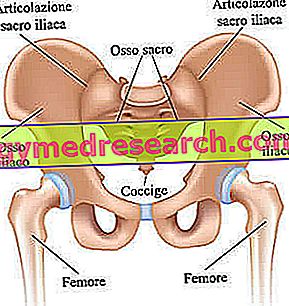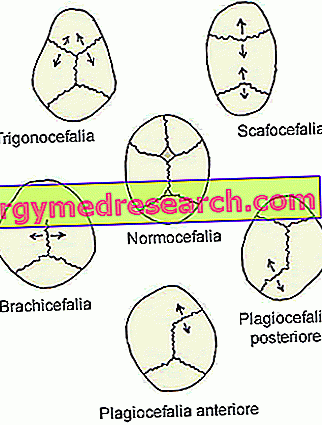Generality
The sacral iliac joint is the joint that joins the sacrum to the iliac bone. Located at the base of the spine, it is an even joint; in the human body there are therefore two sacroiliac joints, one on the right side and one on the left side.

The iliac bones, on the other hand, are bony projections that branch off to the sides of the sacrum and develop downward and forward (pubic symphysis).
The sacral iliac joint includes several ligaments, including: the anterior sacral iliac ligament, the interosseous sacral iliac ligament, the posterior sacral iliac ligament, the sacrotuberous ligament and the sacrospinous ligament.
The function of the sacral iliac joint is to support the weight of the body, when an individual stands up, walks, runs etc.
Short anatomical reference on the joints
The joints are anatomical structures, sometimes complex, which put two or more bones in mutual contact. In the human body, there are about 360 of them and their task is to keep the various bone segments together, so that the skeleton can fulfill its function of support, mobility and protection.
The anatomists divide the joints into three main categories:
- Fibrous joints (or synarthrosis ), lacking in mobility and whose bones are joined by fibrous tissue. Typical examples of synarthrosis are the bones of the skull.
- Cartilaginous joints (or amphiarthrosis ), with poor mobility and whose bones are linked by cartilage. Classic examples of amphiartrosis are vertebral vertebrae.
- Synovial joints (or diarthrosis ), provided with special accessory structures (ligaments, tendons, synovial membrane, joint capsule, etc.) which guarantee their great mobility. Typical examples of diarthrosis are the joints of the shoulder, knee, hip, ankle, etc.
What is the sacred iliac joint?
The sacral iliac joint, or sacroiliac joint, is that even articular element, with a seat at the base of the vertebral column, which connects the sacrum to the right iliac bone and to the left iliac bone .
Anatomy
The sacral iliac joint includes bones, cartilaginous tissues and ligaments.
BONES
As can be guessed from the definition of sacral iliac articulation, the bones that take part in the constitution of the latter are the sacrum and the two iliac bones (the one on the right and the one on the left).
Together with the coccyx, the sacrum and iliac bones constitute the so-called pelvic bones .
- Sacred bone : it is an uneven, asymmetric and triangular bone, which resides in the lower part of the spine, exactly between the lumbar tract and the coccyx.
Representing in fact the posterior and central part of the pelvis (or pelvis), the sacrum comprises 5 vertebrae fused together, identified with the name of sacral vertebrae.
The fusion of the 5 sacral vertebrae is a process that takes place between 18 and 30 years of life.
The interaction between the sacrum and iliac bones is possible thanks to the presence, on the aforementioned bones, of specific articular surfaces: in the case of the sacrum, the articular surfaces are two, one on the right and one on the left.
In addition to the right sacral iliac sacral iliac joint and the left sacrum iliac joint, the sacrum participates in two other joints: the joint with the last lumbar vertebra (which is located above the sacrum) and the joint with the last the first vertebra of the coccyx (which is placed below the sacrum).
- Iliac bone (or coxal bone or hip bone ): it is an even bone, symmetrical and flat in shape, which resides next to the sacrum.
It consists of three regions, which merge with each other at the age of 14th and 15th. The three regions in question are the bones known as: ilio, ischio and pubis.
In the iliac bones, the articular surface that interacts with the sacrum is oriented towards the inside.
In addition to forming the sacral iliac joint, each iliac bone participates in the constitution of two other joints: the joint with the other iliac bone, at the point known as the pubic symphysis, and the articulation with the femur, an articulation better known as the hip .
The iliac bones give insertion to the muscles of the abdomen, to the muscles of the lower limbs, to the gluteal muscles and to the muscles of the back.
CARTILAGINEI FABRICS
The cartilaginous tissues of the sacral iliac joint reside on the articular surfaces that connect the sacrum with the two iliac bones.
Analyzing in more detail the nature of these cartilaginous tissues, in the case of the sacrum the cartilage is hyaline ; in the case of the iliac bones, instead, the cartilage is of fibrous type (or fibrocartilage).
LIGAMENTS
The ligaments of the sacral iliac joint are:
- The anterior sacral iliac ligament . Located anterior to the sacrum and iliac bone, it is a thin ligament, certainly less strong than the other ligaments present in the sacral iliac joint.
Because of its particular subtlety, it is more exposed to injuries.
Origin and insertion: it originates from the pelvic surface of the sacrum (anterior surface) and is inserted into the medial part of the iliac fossa;
- The interosseous sacral iliac ligament . He is the main advocate of the connection between sacrum and iliac bone. Of short length, it is a very strong and resistant ligament.
Origin and insertion: it extends between the sacral tuberosity of the sacrum and the iliac tuberosity of the iliac bone;
- The posterior sacral iliac ligament . Very strong and resistant, it is a ligament that, during the movements of nutation and counter-mutation of the sacrum, stretches and stretches (NB: the movements of nutation and counter-mutation are treated in the chapter dedicated to the functions of the sacral iliac joint)
Origin and insertion: it originates from the lateral sacral crest and inserts itself on the posterior margin of the iliac bone, precisely in the space between the posterior iliac spines;
- The sacrotuberous ligament . It is a ligament formed by three broad bands of fibrous tissue, which merge, at some point in their path, with the posterior sacral iliac ligament. It plays an important stabilizing action during the nutation movements of the sacrum.
Origin and insertion: it originates from the posterior margin of the iliac bone, in the portion between the posterior iliac spines, and from the lateral margin of the wing of the sacrum; it fits into the ischial tuberosity;
- The sacrospinous ligament . Thinner than sacrotuberous and triangular in shape, it has the task of opposing the forward inclination of the sacrum, compared to the two iliac bones.
Origin and insertion: originates at the level of the so-called ischial spine and is inserted, in part, on the lateral margin of the wing of the sacrum and, in part, on the transverse process of the coccyx.
Functions and movements
The main function of the sacral iliac joint is to support the weight of the upper part of the human body, when an individual stands up, walks, runs etc.
MOVEMENTS OF THE SACRED ARTICLE ILIACA
The movements that the human being can perform, thanks to the sacred iliac joint, are:
- The contemporary forward inclination of both iliac bones, with respect to the sacrum;
- The contemporary retroversion (or backward tilt) of both iliac bones with respect to the sacrum;
- The forward inclination of one iliac bone and the simultaneous retroversion of the other iliac bone. This movement takes place during walking;
- Nation (or sacral bending). During this movement, the base of the sacred (NB: it is the upper part of this bone) moves down and forward, while the apex of the sacred (NB: is the lower part) moves backwards. This involves the reduction, in terms of diameter, of the upper narrow of the basin and the enlargement, again in terms of diameter, of the lower strait of the basin;
- Counter-mutation (or sacral extension). During this movement, the base of the sacrum moves up and back, while the apex of the sacred moves forward and down. This involves increasing, in terms of diameter, the upper narrow of the basin and the decrease, again in terms of diameter, of the lower narrow.
What are the upper and lower strait of the basin
In human anatomy, the narrowing of the pelvis that separates the large pelvis from the small pelvis takes the name of the upper narrow pelvis, while the narrowing that marks the lower limit of the small pelvis takes on the name of the lower pelvis.
Remember that large pelvis and small pelvis are the two regions, respectively upper and lower, in which the so-called pelvic cavity can be subdivided.
Associated pathologies
The most important issue that can affect the sacral iliac joint is the condition known as sacroiliitis .




